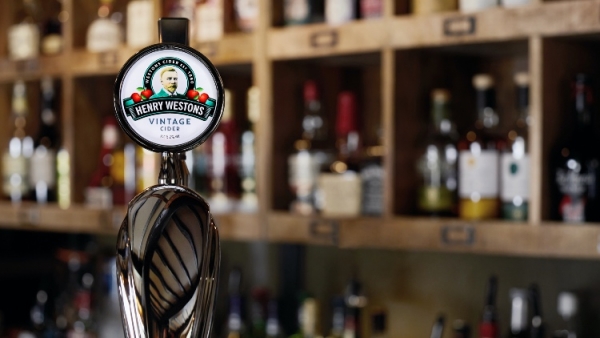In association with Westons Cider
Shaken to the core: how premium cider is becoming more popular in the on-trade

A lot has been made of the clamour for premium draught products among parched pub goers returning to the on-trade after a year heavily punctuated by periods of lockdown and the inevitable migration towards bottles, cans and cupboard cocktails that followed – ‘Quarantini’ anyone?
Within beer, for example, premium and super premium products now make up 50% of volume and are in growth according to Globaldata research. What’s more, for the on-trade specifically, premium and super premium are 35% of volume and growing.
In the cider category specifically, premium draught apple ciders are stealing share from mainstream apple (now accounting for 48.7% of British cider serves (up 1.3 ppts year on year)[1], as drinkers in the post-pandemic world are becoming increasingly attuned to factors such as localism, craftmanship, and heritage.
With a higher price per litre these premium cider serves are set to add value and boost revenue as the trade recovers this year and beyond. Here, The Morning Advertiser (MA) takes a deep dive into how Covid-19 catapulted the premium category.
Consumers ‘seeing cider differently’
A growing number of cider drinkers are plumping for premium off the back of the pandemic – which has driven customers to quality pours and on-trade experiences they couldn’t access behind closed doors.
According to Alistair Morrell, CEO of trade alliance Cider Is Wine, while the National Association of Cider Makers reported that the category has lost sales of 28% and market share of 30% in the last decade, a “re-awakening of consumers seeing cider differently” has been one of the pandemic’s lesser spotted symptoms.
“Of course, it’s small scale compared to the vast oceans of low-grade, low juice content product shovelled into supermarkets at (close to) cost price, but nonetheless a clear indication of the direction that consumption is taking – less but better,” he tells The MA.
“The question is how does this industry better change its value perception and what are the key attributes required in order to achieve a healthy proposition which delivers throughout the supply chain beginning with the customer?
“Trends come and go, some stick and become embedded into the long-term future of an industry,” he adds. “Typically, these will be only where they add value throughout the supply chain from consumer to producer.”
Premium draught cider a ‘key hotspot’
On-trade cider sales are currently worth £783.2m (down 61.1%) however, this is expected to return to growth as outlets reopen – particularly given the average price per pint increased by four pence to £3.90 in 2020.
Draught cider now accounts for 72.5% of total cider sales, up 2.5% as emphasis has shifted to front of the bar. After years of downward movement, packaged cider continues to decline.
Additionally, apple cider still represents the lion’s share of the category, accounting for 60.1% of all on-trade serves, though fruit cider remains an important consideration – particularly in the summer months – now representing 39.2% of on-trade cider sales.
On top of this, the report flags cloudy cider – which represents almost 9% of the total draught apple category in the on-trade – as a must-watch subsector, while crafted cider is also in growth, having increased its share of the on-trade cider category to 13.1% (1.1% growth).
“The figures show that draught ciders – particularly towards the more premium end of the spectrum – will be key hotspots for on-trade retailers to consider when deciding which products to stock,” Tim Williams, insight and innovation manager at Westons Cider explains.
“It’s important to remember that seasonality plays a major role in the dynamic between draught apple and fruit ciders – with fruit ciders proving far more reactive during lighter, summer evenings.
“On-trade retailers should consider rotating these two formats – prioritising a draught fruit cider during the summer months, before swapping this out in favour of a crafted apple cider in late August.”
- The full report – including impartial stocking advice for retailers of all shapes and sizes across the off-trade – is also available for digital download here.
‘Cider value lies in trade’
According to Morrell, while more than a year of on-again off-again trade during lockdown prompted producers of concentrate-based ciders to load supermarkets with volume, it also heralded the resurgence of cider makers geared towards low volumes of high quality – a refreshing turn towards artisan, authentic and, crucially, apple.
“The most recent stats from Westons show that the cider market looks to have survived the pandemic reasonably well having dropped from £3.1bn to £2.1bn between 2019 and 2020,” he says.
The Westons Cider report cited by Morrell reveals that during 2020 almost half of all UK households bought cider in retail, with the cider maker’s head of business development, Darryl Hinksman, suggesting that the pub profits from cider sales are ripe for the taking.
“When the on-trade reopened last summer, cider stole share from beer – increasing its share of on-trade serves from 10.5% to 12%,” Hinksman says of its findings.
“These figures demonstrate both a sustained appetite for cider – which certainly didn’t dip while pubs, bars and restaurants were closed – and an opportunity for the category to attract new drinkers with innovation.”
With this in mind, the founder of Klynk ventures – a firm which works closely with new and disruptor brands to connect them to retailers and shoppers – Hamish Clarke, goes as far as to predict that premium apple cider will pip other categories as the “next big growth market” amid the resumption of pub trading.
“Cider value lies in trade, whereas retail tends to push more volume,” he tells The MA. “That said we can derive that there is willing market looking for and, critically, open to exploring and spending more on ciders alone or with foods.
“We think while the most recent growth of fruit flavoured ciders does meet a specific consumer need, cider seems to have lost its way a little and needs to return to its core – pun intended.”
‘Perfectly primed’ brand
Westons’ report also flags that premiumisation is set to be the driving force for growth across the on-trade, with well over three quarters (87%) of consumers who plan to return to the trading planning to treat themselves and opt for premium offerings
As such, the Herefordshire-based cider maker – run by the fourth generation of the Weston family – is building on the off-trade success of its £65m[2] Henry Westons brand with the launch of Henry Westons Vintage Draught (5.2% ABV) – its first ever draught format.
The decision to tap into the popularity of its premium pour comes off the back of value sales for the Henry Westons brand in retail almost doubling in the past five years – increasing by 90% – and highlighting the newfound appeal of high quality, crafted ciders.
According to its creators, the new Henry Westons Vintage Draught pour will help outlets reinvigorate the premium cider category and drive value growth for the on-trade as consumers “trade up”.
“We’ve seen a huge rise in sales of crafted ciders over the past year, and this sub sector is now growing at a rate over five times faster than the overall category,” Sally McKinnon, head of marketing at Westons Cider, adds.
“Our Henry Westons brand is perfectly primed to help the on-trade make the most of this, established as a benchmark for the highest quality, best-tasting crafted cider.”
Westons Cider Report – The trends driving growth
Highlighting the trends expected to drive growth in the cider category, Westons’ Cider Report flagged:
Premiumisation – set to be the driving force for growth across the on-trade. Well over three quarters (87%) of consumers who plan to return to the on-trade intend to treat themselves and opt for premium pours.
Polarised consumer behaviour – an important consideration. With consumers placing strong emphasis on the importance of good value, as well as high quality, premium mainstream ciders offer an affordable trade-up and will help to propel value growth.
Authenticity and craft – these remain key requirements for discerning cider drinkers, with 30% of British on-premise consumers actively seeking local, British or traditional serves. These more premium products with provenance and heritage attract a higher price per litre and will help to drive higher value sales
Cider stealing share from beer – as restrictions lifted in Summer 2020, cider reached a 12% market value share
Food – pairings provide an opportunity to boost overall spend, with 42.7% of on-trade cider serves accompanied by food – up from 39.5% in 2019.
“We strongly encourage all on-trade retailers to take stock of the advice outlined in the report as we look towards a more positive 2021 and a return to growth,” concludes Darryl Hinksman, head of business development at Westons Cider.
- The full report – including impartial stocking advice for retailers of all shapes and sizes across the off-trade – is also available for digital download here.
Expanded ‘best-selling brand’
On top of this, Henry Westons has the highest pence per litre in the off trade when compared with all draught competitors and was previously the only top five apple cider brand not to be represented on draught.
“Henry Westons is our star-performer in retail, and we’ve built a loyal shopper base who purchase this brand regularly,” McKinnon continues. “In fact, our Henry Westons Vintage retail product is the UK’s biggest glass bottled cider and attracted 66.6% more shoppers in 2020, with one bottle now sold every second.
“By expanding our bestselling brand and bringing a new Henry Westons Vintage Draught liquid to pubs, bars and restaurants, we’re confident we can help outlets capitalise on the brand’s renowned quality and taste credentials.
“Plus, by offering our on-trade customers a premium, trade-up option we will help them to drive greater value sales in outlet.”
[1] CGA Strategy, On Premise Measurement Service, P5 MAT to 22/05/2021 Top 25 Draught Apple Ciders[2] IRI Info scan 52 w/end 19 June ’21









